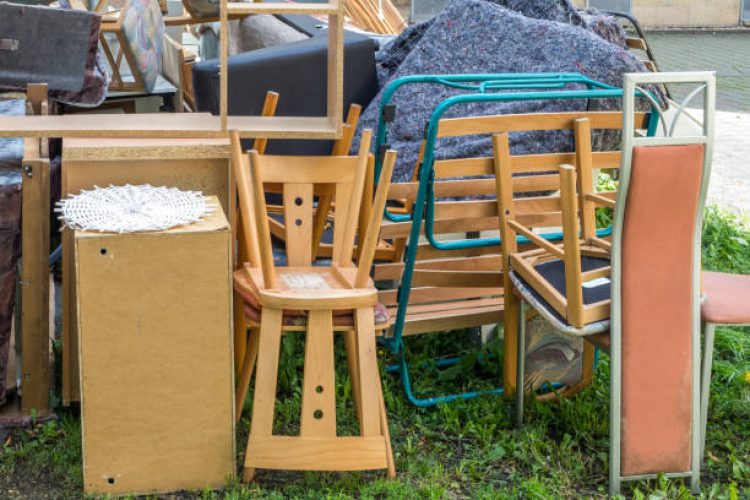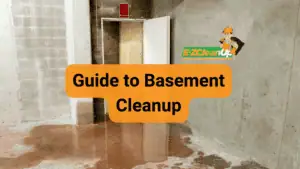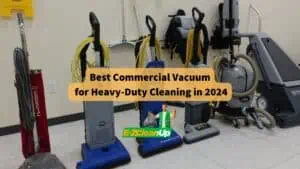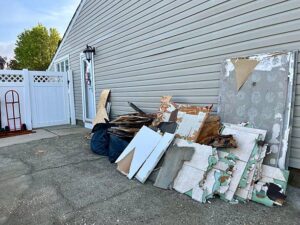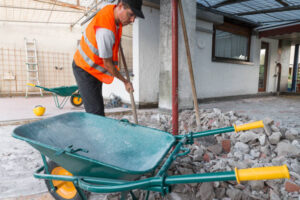Managing construction and demolition waste is one of the biggest challenges in any renovation or building project. Whether you’re tackling a home remodel, tearing down an old structure, or clearing out years of accumulated debris, choosing the right waste management approach can save you time, money, and headaches.
The key to success? Understanding how to strategically combine junk removal services, demolition work, and dumpster rentals into a cohesive waste management plan.
Understanding Your Waste Management Options
Before diving into combination strategies, it’s important to understand each service option:
Dumpster Rentals
Dumpster rentals provide plenty of space for large cleanouts, flexibility to work on your schedule, and simple upfront pricing, with a dumpster delivered to your driveway or jobsite so you can work at your own pace. A local dumpster rental company will typically drop off the bin in your driveway and then return five to 10 days later to haul away its contents.
Best for:
- Multi-day or multi-week projects
- Situations where you can do your own loading
- Projects generating predictable amounts of debris
- Renovations where waste accumulates gradually
Junk Removal Services
Junk removal services offer a hands-off approach to waste management where you hire a team to come to your location and haul away unwanted items in a one-time service that’s completed in a matter of hours.
Best for:
- Quick cleanouts completed in hours
- Heavy or bulky items difficult to move
- Projects where you lack time or physical ability to load debris
- Hazardous materials requiring professional handling
Demolition Services
Professional demolition goes beyond just tearing things down. Developing a waste management plan to handle debris generated during demolition, identifying recycling opportunities for materials such as concrete, metal, and wood, contributes to environmental sustainability and helps manage project costs effectively.
The Hybrid Approach: Combining Services for Maximum Efficiency
The hybrid method splits tasks based on what each service handles best, with homeowners renting a dumpster for lightweight debris like cardboard, paper, and small broken items, while professional junk removal teams handle heavy appliances, furniture, and hazardous materials.
Strategy 1: Dumpster + Selective Junk Removal
This combination is ideal for medium to large renovation projects.
How it works:
- Rent a dumpster for the duration of your project (typically 5-10 days)
- Load lightweight demolition debris yourself (drywall, wood scraps, tiles, packaging)
- Hire junk removal professionals for specific heavy items (appliances, furniture, fixtures)
Cost savings: A typical garage cleanout using only junk removal costs $800-1,200, while the hybrid approach costs $450-700 for the same project, saving $350 and two hours.
Strategy 2: Demolition Service + Dumpster Rental
Perfect for projects requiring professional demolition work.
How it works:
- Hire professionals for the actual demolition work
- Have a dumpster on-site for immediate debris disposal
- Demolition crew loads debris directly into the dumpster
- Handle final cleanup and smaller items yourself
Benefits:
- Streamlines the demolition process
- Keeps the site organized and safe
- Reduces overall project timeline
- Often more cost-effective than having demo team handle all hauling
Strategy 3: Full-Service Approach for Complex Projects
For large commercial projects or complicated residential demolitions with hazardous materials.
How it works:
- Professional demolition team handles structural dismantling
- Multiple dumpsters on-site for different material types (concrete, metal, general debris)
- Specialized junk removal for hazardous materials (asbestos, lead paint)
- Final professional cleanup service
Key Considerations for Effective Integration
1. Plan Your Waste Sorting Strategy
Segregating different types of waste on-site makes it easier to recycle and dispose of waste properly, looking for materials that can be recycled or reused, such as crushing concrete to use it again or saving wood for other projects.
Create designated areas for:
- Recyclable metals
- Wood and lumber
- Concrete and masonry
- General construction debris
- Hazardous materials
2. Size Your Dumpster Appropriately
Choosing the wrong dumpster size can cost you money. Dumpster rental provides the better solution for projects like kitchen remodels because demolition waste, old cabinets, and construction debris accumulate gradually, making the fixed timeline and predictable waste volume advantageous with flat-rate pricing.
Common dumpster sizes:
- 10-yard: Small bathroom renovations, deck removal
- 20-yard: Kitchen remodels, medium demolition projects
- 30-yard: Whole-house cleanouts, large renovations
- 40-yard: Major construction or demolition projects
3. Understand Timeline and Scheduling
Coordinate services to minimize downtime:
- Schedule dumpster delivery before demolition begins
- Plan junk removal pickups for mid-project to clear bulky items
- Keep the dumpster through final cleanup
- Schedule final junk removal after dumpster pickup for any remaining items
4. Know What Goes Where
Not everything belongs in a dumpster. Junk removal companies may not take certain items, like hazardous waste, and may charge more for appliances like refrigerators or air conditioners.
Dumpster-appropriate items:
- Construction debris (drywall, wood, flooring)
- General household items
- Yard waste (check local restrictions)
- Furniture and fixtures
Requires specialized removal:
- Appliances with refrigerants
- Electronics (e-waste)
- Hazardous materials (paint, chemicals, asbestos)
- Tires and batteries
5. Maximize Recycling and Reuse Opportunities
Asphalt, concrete, and rubble are often recycled into aggregate or new asphalt and concrete products, wood can be recycled into engineered-wood products like furniture as well as mulch and compost, and metals including steel, copper, and brass are valuable commodities to recycle.
Work with services that prioritize sustainability:
- Ask about recycling rates and practices
- Choose demolition contractors who salvage materials
- Consider donating usable items before demolition
Cost-Effectiveness Analysis
When to Prioritize Dumpster Rental
Dumpster rental becomes cost-effective at medium project waste volume levels, with a 20-yard dumpster handling most residential cleanouts for $450, while junk removal for the same project requires multiple trips or a full truck, costing $600-800 total.
Choose dumpster rental when:
- Project spans multiple days or weeks
- You can handle loading yourself
- Debris is primarily lightweight construction materials
- You want control over timing and pacing
When to Use Junk Removal
Junk removal services work when you want a hands-off approach or need the job done quickly for hours-long cleanouts, furniture removal or appliance disposal, and while typically more expensive than dumpster rental, these services do the heavy lifting for you.
Choose junk removal when:
- Time is limited
- Items are too heavy or bulky to manage
- You lack the physical ability to load debris
- Project is small (1-2 rooms)
When to Combine Services
The hybrid approach typically offers the best value for:
- Whole-house renovations
- Projects with both heavy and light debris
- Multi-week timelines with periodic heavy item removal
- Situations requiring both DIY and professional help
Environmental and Regulatory Considerations
With millions of tons of waste generated annually from construction projects, demolitions, and renovations, efficient waste management has become a top priority for governments, construction firms, and environmental agencies worldwide.
Compliance Requirements
- Obtain necessary permits before starting demolition
- Follow local regulations for waste disposal
- Document hazardous material handling
- Maintain disposal records for regulatory compliance
Sustainable Practices
- Prioritize deconstruction over demolition when possible
- Sort materials for maximum recycling potential
- Donate usable items to building material reuse centers
- Work with certified waste haulers who follow environmental guidelines
Creating Your Integrated Waste Management Plan
Step 1: Assess Your Project Scope
- Calculate total debris volume
- Identify heavy or hazardous items
- Determine project timeline
- Set waste diversion goals
Step 2: Get Multiple Quotes
- Contact 3-5 dumpster rental companies
- Request estimates from junk removal services
- Ask demolition contractors about debris handling
- Compare pricing, services, and reviews
Step 3: Schedule Strategically
- Book dumpster delivery for project start date
- Schedule junk removal for heavy items mid-project
- Plan demolition work around dumpster availability
- Reserve final cleanup services
Step 4: Communicate with All Parties
- Share project timeline with all service providers
- Clarify responsibilities for each service
- Confirm material restrictions and requirements
- Establish emergency contact protocols
Step 5: Monitor and Adjust
- Track waste accumulation rates
- Schedule additional pickups if needed
- Adjust sorting strategies based on efficiency
- Document costs and savings for future reference
Conclusion
Successfully combining junk removal, demolition, and dumpster rental services requires strategic planning, clear communication, and understanding the strengths of each option. By implementing a hybrid approach tailored to your specific project needs, you can achieve significant cost savings, improve project efficiency, and ensure environmentally responsible waste management.
Remember: the most effective waste management strategy isn’t about choosing one service over another—it’s about intelligently combining multiple services to create a seamless, cost-effective solution that keeps your project moving forward safely and efficiently.
References
- Dumpsters.com – Dumpster Rental vs. Junk Removal Comparison: https://www.dumpsters.com/blog/dumpster-rentals-vs-junk-removal
- Frontier Waste – Dumpster Rental vs Junk Removal Guide: https://frontierwaste.com/resources/dumpster-rental-vs-junk-removal
- U.S. Environmental Protection Agency – Sustainable Management of Construction and Demolition Materials: https://www.epa.gov/smm/sustainable-management-construction-and-demolition-materials
- Angi – Dumpster Rental vs. Junk Removal: Which Is Right for You?: https://www.angi.com/articles/dumpster-rental-vs-junk-removal-pros-and-cons.htm
- 1-800-GOT-JUNK? – Dumpster Rental vs. Junk Removal Company Comparison Guide: https://www.1800gotjunk.com/us_en/blog/decluttering/rent-dumpster-comparison-guide

